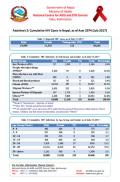What's New
Displaying results 2031 - 2040 of 4899
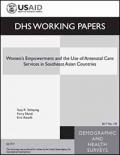
Resource | Publications,
This study assessed the relationship between women’s empowerment and the use of antenatal care (ANC) services in five Southeast Asian (ASEAN) countries. The data used in the study are from the most recent Demographic and Health Surveys (DHS) conducted in Cambodia (2014), Indonesia (2012), Myanmar (2016), the Philippines (2013), and Timor-Leste (2009).
The focus of the analysis was on currently married women who gave birth within the last 5 years before the survey. The two main outcomes were the number of ANC visits they made (four or more compared with none to three), and the timing of the first ANC visit (within the first trimester or later in the pregnancy).
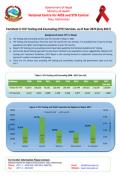
Resource | Fact Sheets,
Background about HIV Testing and Counseling (HTC) in Nepal:
- HIV Testing and Counseling service was first started in Nepal in 1995.
- HIV Testing and Counseling is the entry point for overall HIV care services. It is provided free of cost to the key populations at higher risk and general population all over the country.
- Nepal’s HIV testing and counseling services have been guided by the National Guidelines for Testing.
- Community based testing approach has also been initiated in key population and as suggested by National HIV Testing and Treatment guidelines, 2017 Nepal is also moving forward to implement community led testing to approach in order to maximize HIV testing.
- There are over 175 service sites providing HIV testing and counseling, including 136 government sites as of July 2016.
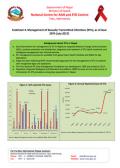
Resource | Fact Sheets,
Background about STIs in Nepal:
- Key interventions for management of STI in Nepal are targeted Behavior Change Communication (BCC), condom promotion and distribution, diagnosis and treatment of STIs (both syndromic and etiological management) and referral services.
- STI management services are available from government health facilities and NGOs for key population.
- Nepal has been following WHO recommended approach for the management of STIs in patients with recognized signs and symptoms.
- The first National STI Case Management Guidelines was developed in 1995 and revised in 2014.
- Repeated Integrated Biological and Behavioral Surveillance (IBBS) Surveys are the main source of information for STI prevalence among key population in Nepal.

Resource | Fact Sheets,
Background about ART program in Nepal:
- ART service started from February 2004 from Sukraraj Tropical and infectious Disease Hospital, Kathmandu in Nepal.
- ART is available for free of cost for People Living with HIV (PLHIV).
- As of July 2017, there are 68 ART sites and 25 ART Dispensing Centers (ADCs) throughout the country.
- ADCs are established to increase accessibility to the treatment.
- Nepal has also adopted Test and Treat approach since Feb 2017.
- National Consolidated Guideline for Treating and Preventing HIV in Nepal 2014 and revised in 2017 is the guiding document for providing HIV treatment and care in Nepal.
- CD4 count service is available from 30 sites and across the country.
- Viral load testing service is available from National Public Health Laboratory
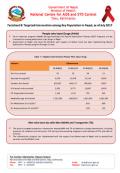
Resource | Fact Sheets,
HIV data and information on people who inject drugs (PWID), men who have sex with men (MSM) and transgender (TG), female sex workers (FSW) and their clients, children affected by AIDS (CABA) and prison inmates in Nepal.
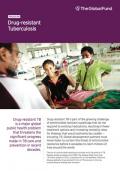
Resource | Publications,
Drug-resistant TB is part of the growing challenge of antimicrobial resistant superbugs that do not respond to existing medications, resulting in fewer treatment options and increasing mortality rates for illnesses that would ordinarily be curable — including TB. Global development partners must move faster to contain this threat of antimicrobial resistance before it escalates to claim millions of lives around the world.
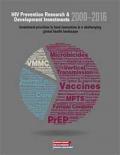
Resource | Publications,
In its 13th annual report, the Resource Tracking for HIV Prevention Research & Development Working Group ("Working Group") documents research and development spending for the calendar year 2016 and analyzes funding trends spanning 16 years.
Between 2000 and 2016, the Working Group has tracked over US$17 billion in investment towards biomedical HIV prevention research and development (R&D1) (Figure 1). The 2016 report analyzes over 600 donor-identified disbursements, as well as R&D spending trends for the following prevention options: AIDS vaccines, microbicides, pre-exposure prophylaxis (PrEP), treatment as prevention (TasP), medical male circumcision (VMMC), female condoms, prevention of vertical transmission (PMTCT) and HSV-2 vaccines. Cure research and therapeutic vaccine investments were also tracked as part of a comprehensive analysis of the HIV R&D landscape.
In a constantly evolving field, the Working Group estimates serve as a comparative cross-sectional and retrospective analysis of interventions, funding sources and strategies to evaluate the impact of public policies and to provide support for advocacy. This work also provides the transparency needed for funders, policy makers and HIV/AIDS advocates to best understand HIV prevention R&D investment flows and to generate strategies for the future.

Resource | Publications,
This briefing paper illustrates how Sustainable Development Goal (SDG) 3, Ensure Healthy Lives and Promote Well-Being for All at All Ages, is relevant to the specific health needs of lesbian, gay, bisexual, transgender, and intersex (LGBTI) people. The paper highlights existing data pertinent to the health and well-being of LGBTI people across seven targets within this Goal, as well as relevant data gaps. The paper then makes a series of recommendations regarding what type of data and indicators Member States should report in order to effectively monitor progress on LGBTI health needs and ensure implementation of SDG 3 is truly universal and in line with the SDGs principle of "leave no one behind."
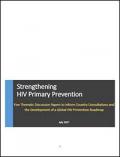
Resource | Publications,
In 2016, United Nations (UN) Member States committed to reducing the number of new adult HIV infections to fewer than 500 000 by 2020, a 75% reduction compared to 2010. Reducing the number of new HIV infections is also an indicator (3.3.1) in the Sustainable Development Goals, among which is the goal of ending the AIDS epidemic by 2030.
Global programmatic targets have been formulated also for primary prevention, underpinning the 75% reduction in new infections. That reduction is to be achieved by reaching 90% of young women and their male partners in high-incidence settings and 90% of key populations everywhere with combination prevention programmes by 2020, while continuing to scale-up HIV treatment.
The five thematic discussion papers in this collection were prepared by members of the Global Prevention Coalition Steering Group and other experts from various institutions and countries. Contributors are listed in alphabetical order. The five papers are meant to inform country consultations and the development of a Global HIV Prevention Roadmap.






